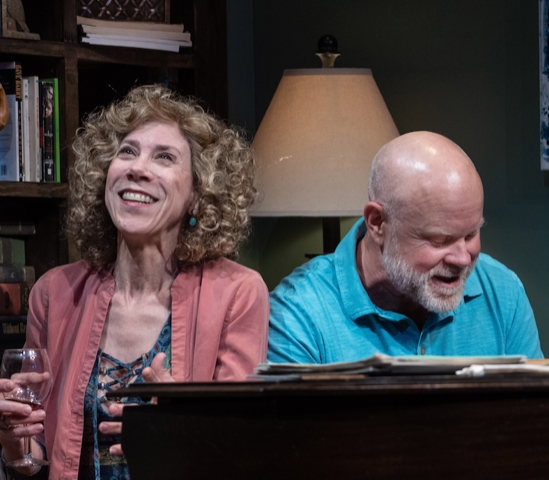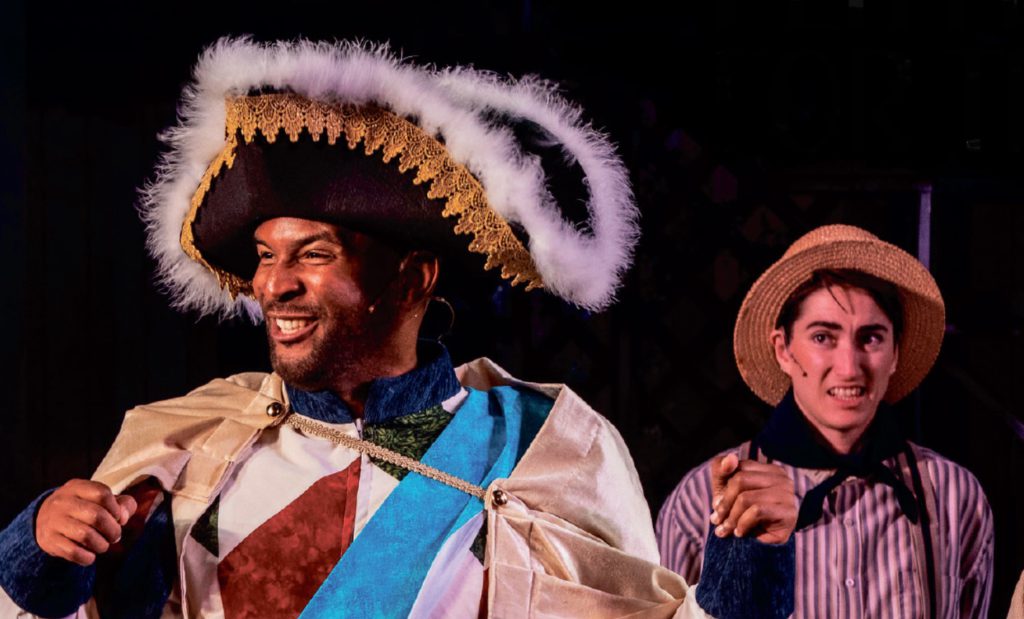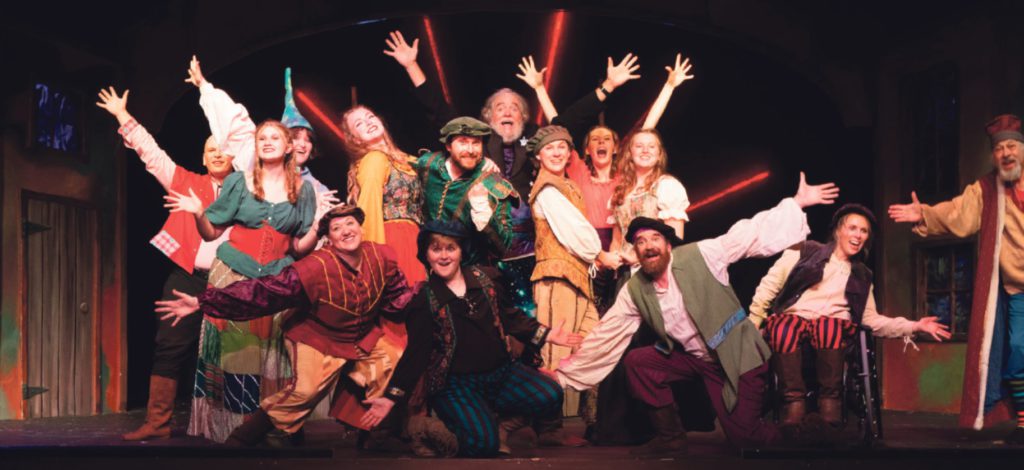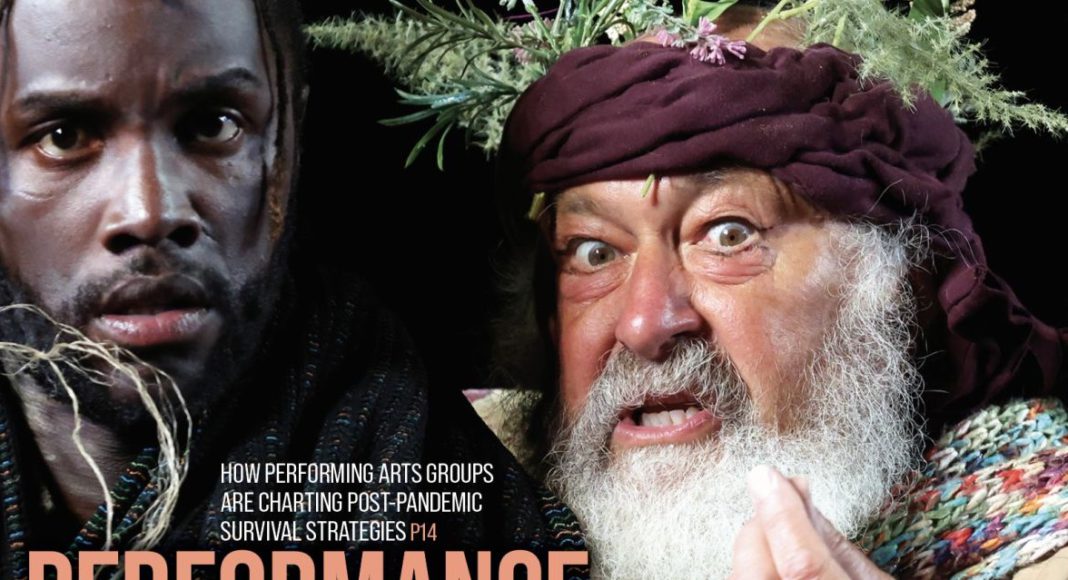The sheer magic of the moment vs. the time and money to make it happen—live performance is a delicate balance, and never more so than after the down-time of Covid, rising cost of productions, and erosion of reliable, passionate audiences.
As our community mourns benefactor Rowland Rebele, many arts groups look ahead and see more challenges than solutions. Rebele, who with his wife Patricia, gave unstintingly to support so many Santa Cruz arts groups, defined agenda-blind philanthropy. He loved the arts and gave with a heart as open as his wallet. It’s no exaggeration to say that the high level of artistic offering in this county thus far would not exist without him.
And now that he’s gone, performance in this town is busy rethinking game plans, strategies, production costs, and the size and shape of upcoming production schedules.
“Many people just simply got out of the habit of attending performing arts events,” actor Julie James told me last year after the quarantine was lifted. And many younger potential theater-goers turned to social media and online entertainment. Live performance, with its skyrocketing costs, has a huge challenge going forward.
How will we move forward beyond 2024? How will new audiences be convinced to spend money to sit for several hours watching new plays or listening to unfamiliar music. How can live theater compete with inexpensive, immediate gratification?
“An estimated 25% to 30% of audiences have not returned since the shutdown enforced by the coronavirus pandemic between March 2020 and late 2021,” David Smith wrote in The Guardian last summer.
“Older people have apparently lost the theater-going habit. . . Younger people are commuting less and working from home, where Netflix and other streaming temptations are just a click away. . . .At the same time mounting productions, running buildings and wages are getting more expensive. Federal government aid that kept many theaters alive during the pandemic is mostly exhausted. Donor patience and pockets are wearing thin. As a result, some regional theaters have been forced to curtail their season or close entirely.”
There are countless such commentaries. “It is without question the hardest time to be producing theater in my lifetime,” says Christopher Moses, artistic director of the Alliance Theater in Atlanta. “All of the theater leaders that I’ve talked to have not quite seen a situation like this. It’s a really precarious time.”
Santa Cruz’ performing arts organizations have been more active than ever in addressing the realities of smaller audiences, higher operating and production costs, and the need to invigorate new audiences in culture beyond streaming.
We asked reps from the Jewel Theatre, Santa Cruz Shakespeare, Mountain Community Theater, Actor’s Theatre, Cabrillo Festival of Contemporary Music, and the Santa Cruz Symphony to weigh in on the future of their organizations.

Julie James, Jewel Theatre Artistic Director
GT: Given that prospective patrons are overwhelmed with an abundance of entertainment choices, how would you defend the irreplaceability of the live theatrical experience?
JJ:The energy and synergy that exists between the actors and the audience in a live theatrical performance is impossible to achieve through other media. We are creating characters in specific, intimate situations (the “world of the play”) and simultaneously completely sharing that with the audience who bring all of their own experiences and interpretations of what is happening before them into the room. The audience feels each actor differently, and the actors feel each audience differently. That makes for an entirely unique and substantive experience (be it comedy or drama) for both actor and audience, each and every night. Who wouldn’t want to create and experience that in some way?
GT: With the lessening of older audiences, how do theaters build a future for live performance?
JJ: Even with lower (or free) tickets and promos, younger people aren’t going to come unless you do something that appeals to them (and expand targeted advertising on appropriate platforms) and even then it’s never a guarantee they’ll show up. People’s time for theater is varied — teenagers have many interests, young adults (20s/30s) are studying and/or working several jobs, or they’ve started a family. I think this age-old issue has always relied on a combination of efforts across the arts field and the community to cultivate a love of live theater in the younger generations which inspires them to become theater-goers in adulthood (and/or become creators in the field): Families bringing their children/youth to see (age appropriate) theater performances, vibrant theatre programs in and out of school (grammar through high school and college), performing arts companies including programming (w/ expanded advertising and affordability) with different themes that can be of interest to a variety of ages across their seasons. And let’s not forget all of that takes reliable, robust public and private funding for the performing arts (something else going extinct after Covid) on top of ticket sales and individual donors to keep all those elements alive and thriving.

Lorne Dechtenberg, incoming Managing Director of Santa Cruz Shakespeare
GT: How can you grow your audience?
LD: During the pandemic, I researched over a thousand American performing arts organizations (theaters, orchestras, operas, and ballets) to see how they were approaching this challenge. Most companies fell into one of two categories: either they were focused on endowment and planned giving by older patrons as a way to keep the doors open, or they were beating the bushes to build a new, younger audience (in some cases this effort required reinventing the organization in a more hip, tech-savvy way).
My goal for SCS is to encourage both legacy giving and new audience development, but to make sure that each task is done with the other in mind. That is, when we ask someone to include us in their estate planning, I want them to understand how transformative their gift will be. It won’t just pay the electric bill; it will enable us to bring Shakespeare to generations of new audience members – and not only his plays, but also his incredible legacy of literacy, cultural awareness, and social justice – things that make every society better. And conversely, when we reach out to prospective new audience members (through community partnerships, multilingual marketing, etc.), I want them to understand that, when they join the SCS family, they won’t just see a single production; they’ll have the opportunity to begin their own traditions – of picnics and plays, of friendships and family gatherings, and of celebrating our shared humanity.
GT: How do you convince consumers that live theater is not a luxury, but rather a necessity for life?
LD: We live in a world full of labels that categorize us and separate us from one another, but when we sit in those seats and experience the emotional arc of a show together, we stop being those labels and go back to just being people. I once heard a director say to a cast on opening night, “You’re going to change the world tonight. People don’t walk out of a theater and commit a crime. Theatre makes the world better. You are about to make the world better.”
Politics in terms of things like pronouns, diversity casting and land acknowledgements should not be the way we aim to capture audience members. I believe that any arts organization that tries to live by its politics will die by its politics. We have a gender parity policy in our casting because we believe it’s the right thing to do. But SCS is not about tokenism or fads; we believe in the great work that we do (both onstage and off) and the human connections that we build.
Riley Nicholson, incoming Executive Director of the Cabrillo Music Festival
GT: How will you grow audiences in a post-Covid era of online entertainment, and changing taste in what constitutes musical performances?
RN: Built into the very nature of our mission, we are constantly presenting the foremost voices of today and their vision of what orchestral music is today. If we do our job right, we can remain flexible enough to stay at the forefront of what it means to present orchestral music today by giving artists the agency and power to renew what is possible in writing music for orchestra. One great example is our upcoming Creative Lab commission curated, composed and produced by Bora Yoon and her collaborators, Sozo Artists, which will utilize technology, musician placement in the hall, production effects, and more for a concert like no other that the festival has seen.
GT:Do you envision new outreach strategies?
RN: We are still very much in planning mode for the season, but some things we are considering include: potential cross-organizational partnerships to collaborate with local and regional peer organizations and cross-pollinate audiences; implementing additional press strategies to attract national press; and additional marketing strategies to help get the word out to targeted segments of our local and regional communities.
GT: What is one of the central challenges you face at this moment in the festival’s history?
RN: The biggest challenge right now is a major shift in foundational support for the arts, which is affecting us and other peer organizations. We are hard at work to stabilize fund development, as several important institutional funders have changed their giving strategies. The festival has a strong foundation to tackle this challenge, but the funding models in the sector are shifting quickly, so my job is to lead and facilitate as our board and team adapt and plan for the future.
Suzanne Schrag , Santa Cruz County Actors’ Theatre Board President
GT: Why is live theater important in an era of streaming and online entertainment?
SS: I don’t have an easy answer, but I know there is something about coming together in the dark, or even in broad daylight, to witness and share in the telling of a story about this human journey we’re all on—whether it involves laughing at absurdity, grieving with empathy, learning about an experience different from our own, or seeing our own experiences validated—that is happening right now, in the moment, unfolding with the collective breath, whether the words were written centuries before, or last year, or are being made up on the spot. Live performance creates that energetic exchange in real time, an increasingly rare and special thing in our world today.
GT: How do you address rising production costs?
SS: I do worry that theater is becoming unaffordable to any but the financially privileged. Because our country does not fund the arts as a matter of course, finding a balance between staying afloat financially amid increasing production costs for both materials and personnel, and keeping tickets at a price point that keeps them accessible is tricky. We’ve tried to solve that a bit by offering a two-for-one ticket deal for all Thursday performances going forward, but I think there are other things we need to explore as well.
We are moving more and more toward keeping production values simple—just enough to tell the story—relying on the directors and actors rather than elaborate sets and costumes to make the pieces compelling. And we still very much have our roots in community theater, where the joke is that the couch from your house spends more time on stage than in your living room, so everyone chips in to find props and set pieces. That’s part of what makes it fun for me–how can you do as much as possible with limited resources? I do think that simple aesthetics is a sweet spot for us–keeping the focus on good acting and good direction to tell the story well and in a way that makes it matter to the people who come to see/hear it.
Gary Reece, Executive Director of the Santa Cruz Symphony
GT: How can live orchestral music appeal to young people?
GR: A big part of the enjoyment is being immersed in the audience and having a multi-sensory experience. You hear the music from all around, you can watch the musicians’ emotions and technique as they perform, and the musicians benefit from having live reactions from the audience.
For each concert, we have been offering a limited number of $10 tickets to people who may not have attended the symphony before. Our pops concert in June begins with a popular street party and food trucks. Then the concert features familiar music, such as the John Williams movie themes we will present this year.
GT: Are there plans to scale down productions for cost-cutting?
GR: We already program performances that require fewer instruments and musicians, as well as those with a full orchestra. This helps us economize while still offering a variety of presentations.
Presenting more productions but on a smaller scale would still require renting the Civic and the Mello each time, along with the same number of facility staff. We are not charged less for a smaller production because the entire facility is rented each time.
We also offer four or five recitals each season, which feature a two-hour performance by a single featured musician in a more intimate Cabrillo College recital hall. This gives the musician the opportunity to engage directly with the audience. Piano virtuoso Gwendolyn Mok, our most recent musician, gave terrific insights into the music of Ravel, which she featured in her recital.
GT: How do you balance the desires of musicians for new music challenges with audiences’ comfort with old classics?
GR: Our challenge is to present a balance of traditional music with newer music. So, Maestro Danny Stewart offers a newer piece in each concert while also presenting the more familiar classics. Admittedly, some people prefer the traditional music because it’s something they already know. But the new pieces are appreciated and valued, as well.

Peter Gelblum and Susan McKay, past and present Directors of Mountain Community Theater
GT: Characterize the role of MCT in the 21st century overload of online entertainment.
MCT: MCT has multiple roles to play that cannot be filled by anything other than live theater. Every kind of live theater, indeed, any kind of live performance with an audience, creates a space filled with an energy that is unique to that place and that particular performance. That unique energy is generated by the performers, the audience, and the interaction of the two groups—every performance is different and every audience is different. That energy exists only with live performances.
MCT also takes seriously its role as a training ground for community members—from children to seniors—to learn how to put on a theatrical production; how to act, direct, produce, design and hang lights, design and build sets and costumes, run a box office, and the other myriad tasks involved in mounting a production.
None of these things can be done online or by a streaming service.
GT: How do you keep costs down?
MCT: We haven’t yet done a one-person show, but have done many with small casts. There is also a financial downside to a small cast, because there are fewer cast members to bring in their friends and family members. We have been using projections to great effect for at least a decade, not so much to save money as to create more opportunities for visual settings, particularly in productions that are done on the floor of the theater and in the round, where a physical set would get in the way.
We always do our best to hold costs down, primarily to enable us to keep ticket prices low.
GT: How to balance the new and untried vs. old favorites when selecting what to produce?
MCT: Based on attendance for the last two seasons, we made a decision to go for more well-known, popular, upbeat shows in 2024. However, we also chose to do one lesser known show that is, nevertheless, ultimately upbeat.
Finally, I reached out to the renowned 90-year-old Oregon Shakespeare Festival at Ashland, recently experiencing severe challenges as far as programming and funding. Artistic Director Tim Bond.
“Live theater, and in particular the specific experience that the Oregon Shakespeare Festival is known for, has to be seen and heard firsthand. For generations, OSF has been a unique place that is not only a destination for school field trips but has also sent teaching artists out to schools on the West Coast and beyond, to engage with students and spark the interest of theater early in their lives.”














Glad to see this story covered- way to go!
Great article. I have always been a huge fan of the theater and music in the Santa Cruz area! We loved going to all the Shakespeare performances especially the ones with Joseph Riberio!
It’s a huge problem for all ages and communites when going to a venue equals contracting Covid. When a venues over pack humans into production or music without concern for health it ruins it for everyone.
We just went to overpacked music show in Felton Ca where all 5 of us came down with Covid 6 days later.
It will be the last time at this venu for me and most my friends because we don’t feel safe due to the sheer number of people they allowed in to the venue. This is unfortunate because the music options are great!
Just my 2 cents.